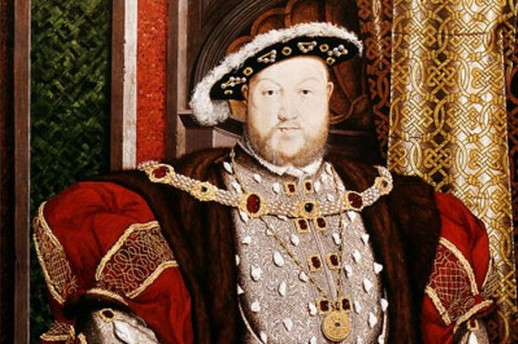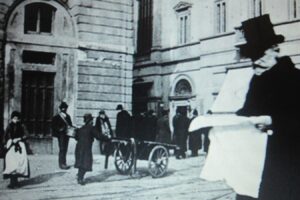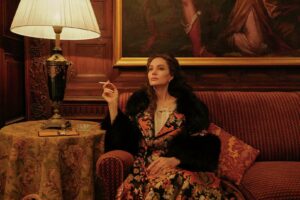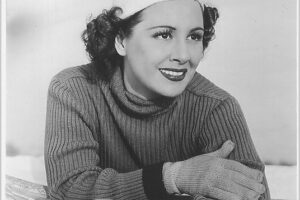

Samson et Dalila (1877) had problems at first because many countries did not permit the staging of Biblical dramas, but in Samson the composer demonstrates an excellent grasp of the dramatic deployment of the chorus, so it worked very well as an oratorio with typical grand opera accouterments such as ballets, seduction duets, prison soliloquies and gaudy pagan religious rituals. If you’ve got a mezzo with sex appeal, a tenor who declaims forcefully and a fine chorus, Samson will be a hit. Stage directors who do catastrophe well also have an opportunity to dazzle with it.
Last Sunday, the Bard Music Festival, in a French mood (earlier this month there was a staging of Chabrier’s Le Roi malgré Lui), gave a concert performance of Saint-Saëns’ true grand opera, Henry VIII, which had its premiere at the Garnier in 1883. This work plays to many of the same strengths as Samson but also, as the Opéra required, with an elaborate ballet (much cut on our present occasion as it is only incidental to the plot), a dark mezzo-fatale role for Anne Boleyn, and many grand chorales.
The influence of Wagner’s concertati in Lohengrin and Tannhäuser (more than thirty years old but still new to most French opera lovers) is paramount here, as is the unbroken flow of scene to scene, idea to idea, in the Wagnerian pattern, rather than the distinct numbers of the operas of Meyerbeer, Verdi and even Berlioz. Yet Saint-Saëns had a livelier, more Gallic gift for melody than Wagner (I was sometimes reminded of Les Contes d’Hoffmann) and therefore no need to subtly extend his themes to fill an archetypal night. The four principal roles are nicely differentiated, the smaller parts well characterized.
There is so much excellent music in Henry, such grandeur of effect, that it is unclear why it never joined the standard repertory. The work arrived late, of course, in the age for grand opera—the lighter works of Bizet and Massenet were in vogue, to be succeeded by those of Charpentier and Debussy. There is also a rather awkward libretto that, like most attempts to simplify the complex personal, political, religious and dynastic issues of Henry VIII’s reign, falls back on cliché rather than exploring personality. Verdi proved in Don Carlos that contemporary themes could be juggled and comprehended within a historical framework, with characters who begin as caricature and grow musically, dramatically into human beings. But the libretto of Henry VIII leaves too many questions unanswered or unaddressed.
The central matter is the king’s so-called divorce, driven rather more by Henry VIII’s need for a male heir for his brand new dynasty than by passion for another woman. The dynastic argument might be difficult to express operatically and in Saint-Saëns’ opera (as in Donizetti’s Anna Bolena) it never comes up. After twenty years of happy marriage to Catherine of Aragon, the daughter of Ferdinand and Isabella, Henry had only one legitimate child, Mary, handsome and clever but the wrong sex.
He found an answer in the Book of Leviticus, a prohibition against marrying one’s brother’s widow! (In the Book of Genesis one is ordered to marry her, but never mind.) Popes were usually indulgent in such circumstances, but Clement VII’s Rome had just been ransacked by 50,000 troops of Catherine’s nephew, Emperor Charles V, he of many thrones and many operas. The pope’s hands were, so to say, tied. So, taking a leaf from the book of Martin Luther (whom he had previously denounced), Henry denied the pope any authority over the English church and proclaimed himself a bachelor. Then he married Anne Boleyn.
There is plenty of drama in this story. The problem, as Shakespeare (a partial source) found, is that it doesn’t boil down very clearly. Something important must be trimmed (if only the time line) for dramatic thrust to emerge. Saint-Saëns’ librettists came up with that ancient standby, the purloined letter—written by Anne to a previous lover (the Spanish ambassador no less!)—that may have fallen into the hands of Queen Catherine. The queen thus knows Anne has been lying to at least one of her two lovers—but what will she do about it? (Isn’t it a woman’s prerogative to change her mind? As those who saw Anna Bolena will remember, it was Anne’s adultery after her marriage to Henry that constituted high treason.)
Still, we get a high-impact patriotic chorus, the presentation of the new and nervous Spanish ambassador to the menacing king, Anne’s nervous reflections on the spot she is in—and just enough naked ambition to make us admire her bitchery—and several persons interrupting nervous duets. The papal legate holds a trial, where Catherine pleads for mercy without mentioning her firm conviction that she was a virgin at her first husband’s death and therefore perfectly eligible to marry his brother. This leads to a very grand scene for five voices with choral thunder to back them up. And Henry marries Anne. But the dying Catherine still has that damned letter. Will she make use of it?
The role of Henry VIII requires a basso cantante of smooth line and, when necessary, overwhelming power, a man whose whisper can be a threat but who can carry you off your feet when he sings of love. Jason Howard had the proper look and the proper line, but the part lies high and he was not comfortable a good deal of the time.
Ellie Dehn, so appealing in the Met’s Satyagraha, had the sympathetic role of Catherine of Aragon; she held our attention and sympathy in the great courtroom scene and in her self-searching elsewhere. She may lack the chest voice to put this role over in a huge house, but she was immensely appealing in Bard’s Sosnoff Theater. Jennifer Holloway, Anne Boleyn, sang a sexy, appealing performance, but her lower notes tended to vanish under the weight of full orchestra. John Tessier took the rather thankless role of Don Gomez, Spanish ambassador and rejected suitor; his light, attractive tenor was not especially effective.
Jeffrey Tucker was impressive in the brief bass role of the Cardinal Legate: One took note when he made a pronouncement, and that he was undaunted by the political chicanery around him. Steven Moore and Darren Lougee were standouts as trial Judges, but all the small roles were effective.
The American Symphony Orchestra under festival director Botstein played this elaborate and intriguing score beautifully, seeming to enjoy its intricate expressive effects (bird calls, Highland snaps) as much as we did. Botstein’s unparalleled sweet tooth for unusual music struck a sugarplum this time: We all wondered why the opera is so rarely performed. The chorus, to whom Saint-Saëns was especially attentive, did admirable work directed by James Bagwell.
In lieu of full staging, Henry VIII was given with subtitles and a play of projections on screens, segmented Holbein portraits of our characters or Victorian illustrations for the trial. Perhaps this added something to audience comprehension; in any case it was not as distracting as it might have been. The best scenic effect, however, was Miss Holloway’s crimson gown with what looked like Aubrey Beardsley peacock inlay. One glance at that and you knew she was (playing) a wicked woman and that we were attending the (grand) opera.
Reach your audience through parterre box!
parterre box, “the most essential blog in opera” (New York Times), is now booking display and sponsored content advertising for the 2023-2024 season. Join Carnegie Hall, Lincoln Center, Warner Classics and many others in reaching your target audience through parterre box.
parterre box, “the most essential blog in opera” (New York Times), is now booking display and sponsored content advertising for the 2023-2024 season. Join Carnegie Hall, Lincoln Center, Warner Classics and many others in reaching your target audience through parterre box.
-
Topics: bard summerscape, cher pubic, leon botstein, review, sugarplums
Call for submissions: parterre box‘s new Talk of the Town
parterre box is launching a new themed regular feature curated by our readers and opera fans across the world! We are asking for your favorite clips, recordings, and anecdotes to get people chatting, listening, and thinking.
parterre box is launching a new themed regular feature curated by our readers and opera fans across the world! We are asking for your favorite clips, recordings, and anecdotes to get people chatting, listening, and thinking.
parterre in your box?
Get our free weekly newsletter delivered to your email.

























Comments